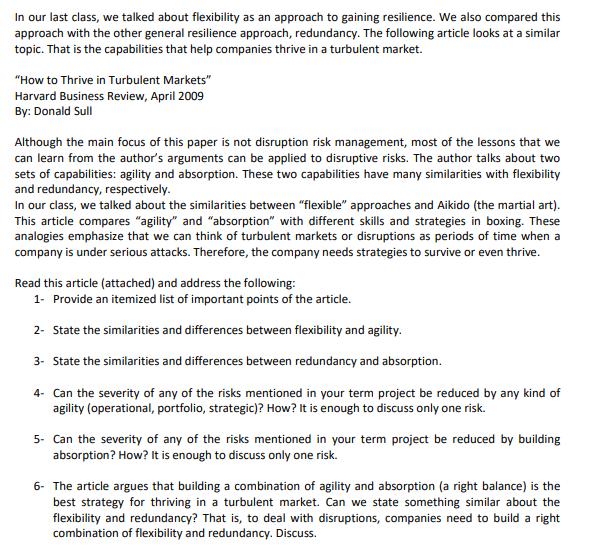Answered step by step
Verified Expert Solution
Question
1 Approved Answer
In our last class, we talked about flexibility as an approach to gaining resilience. We also compared this approach with the other general resilience

In our last class, we talked about flexibility as an approach to gaining resilience. We also compared this approach with the other general resilience approach, redundancy. The following article looks at a similar topic. That is the capabilities that help companies thrive in a turbulent market. "How to Thrive in Turbulent Markets" Harvard Business Review, April 2009 By: Donald Sull Although the main focus of this paper is not disruption risk management, most of the lessons that we can learn from the author's arguments can be applied to disruptive risks. The author talks about two sets of capabilities: agility and absorption. These two capabilities have many similarities with flexibility and redundancy, respectively. In our class, we talked about the similarities between "flexible" approaches and Aikido (the martial art). This article compares "agility" and "absorption" with different skills and strategies in boxing. These analogies emphasize that we can think of turbulent markets or disruptions as periods of time when a company is under serious attacks. Therefore, the company needs strategies to survive or even thrive. Read this article (attached) and address the following: 1- Provide an itemized list of important points of the article. 2- State the similarities and differences between flexibility and agility. 3- State the similarities and differences between redundancy and absorption. 4- Can the severity of any of the risks mentioned in your term project be reduced by any kind of agility (operational, portfolio, strategic)? How? It is enough to discuss only one risk. 5- Can the severity of any of the risks mentioned in your term project be reduced by building absorption? How? It is enough to discuss only one risk. 6- The article argues that building a combination of agility and absorption (a right balance) is the best strategy for thriving in a turbulent market. Can we state something similar about the flexibility and redundancy? That is, to deal with disruptions, companies need to build a right combination of flexibility and redundancy. Discuss.
Step by Step Solution
★★★★★
3.45 Rating (152 Votes )
There are 3 Steps involved in it
Step: 1
Operational Risk Management Case Provide an itemized list of important points of the article The article revolves around the flexibility and agility of the true champion in the boxing match All this a...
Get Instant Access to Expert-Tailored Solutions
See step-by-step solutions with expert insights and AI powered tools for academic success
Step: 2

Step: 3

Document Format ( 1 attachment)
627b8110409b7_101578.docx
120 KBs Word File
Ace Your Homework with AI
Get the answers you need in no time with our AI-driven, step-by-step assistance
Get Started


